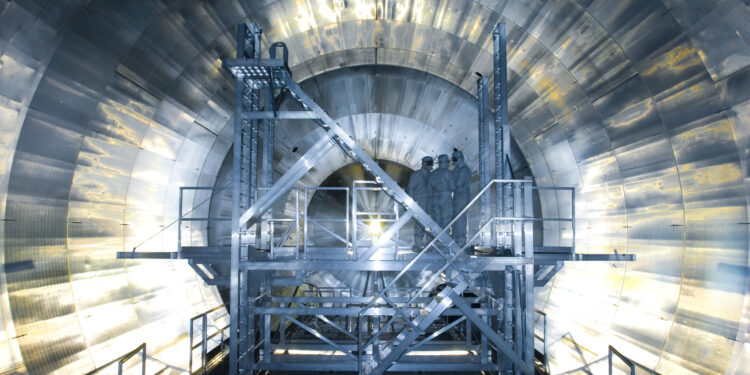Installation of the internal electrode system of the Katrin’s main spectrometer. Credit: Markus Breig, Kit
Scientists trying to discover the elusive mass of neutrinos, tiny “ghost particles” which could solve some of the greatest mysteries in the universe, announced a new limit on Thursday for how much they could weigh, reducing the previous estimate.
Since the existence of Neutrinos was proposed almost a century ago, scientists from around the world have struggled to learn a lot about them, especially their mass.
This is important because the neutrino, as the most abundant particle in the universe, “weaves a thread that connects small and infinitely large”, “Thierry Lasserre, physicist of France, alternative Energies and Atomic Energy Commission, told AFP.
His mass “influences the structures that make up the cosmos,” he added.
These invisible particles are washed through the universe from the big bang 13.8 billion years ago.
The number of neutrinos is difficult to understand – there are about a billion for each atom of the cosmos.
However, because they have so little mass and have no electrical load, neutrinos rarely interact with matter.
For example, we think that thousands of billions of these so-called ghost particles are going through human bodies, with us, no wiser.
This makes them extremely difficult to study. But not impossible.
Hunt ghosts
More than a hundred scientists from six countries have tracked up the Neutrino since 2019 as part of the Katrin collaboration at the Karlsruhe Institute of Technology in Germany.
In a study published in the journal Science Thursday, collaboration announced that the mass of a neutrino cannot exceed 0.45 Volts electron.
This represents less than a billionth of the mass of a proton, which is within the nucleus of each atom.
The new upper limit for the mass of a neutrino is about half of the figure Katrin announced in 2022 after his first measures.
Katrin uses a solid spectrometer to record the disintegration of the tritium, a radioactive hydrogen shape which releases both electrons and neutrinos.
These particles revolve around a structure 70 meters long (230 feet long) dominated by the 200 -ton spectrometer, which works under vacuum.
Raman Laser system for the analysis of the composition of tritium gas in WGTS. Credit: Tritium Laboratory, Kit
The electron and neutrinos share the energy produced by the decomposing tritium. The trick therefore consists in measuring the energy of the electron to deduce information on the neutrino.
This requires measuring many electrons.
Six million had to be measured to obtain Katrin’s first results in 2022.
And it took 36 million to reach the most specific figure announced Thursday.
“When we have collected all of our data by the end of the year,” said the team to measure around 250 million electrons, said Lasserre.
It will be the moment of truth.
Either the experience will have finally discovered a “trace” of the neutrino – or determined that its mass is less than 0.3 volts electron, explained Lasserre.
Dark energy
Scientists hope that the mass of the mass of neutrinon will help to unravel several obstinate secrets of the cosmos.
Despite their incredible lightness, neutrinos were included in some models seeking to explain the dark energy – the unknown force considered to cause the ever -heavier expansion of the universe.
It is believed that around 95% of the universe is made up of black energy and also unknown dark matter, leaving only 5% for everything else.
Source section of Katrin’s experience. Credit: Schwerdt-Fotografie, Heidelberg
Katrin’s collaboration plans to create a new detection system, called Tristan, to hunt a new breed of neutrinos called sterile neutrinos.
These hypothetical particles do not interact with matter, but have much more mass than normal neutrinos.
Some scientists have proposed that these strangely heavy neutrinos could actually be what we know as a dark matter.
More information:
Direct measurement of the mass of neutrinos based on 259 days of Katrin data, Science (2025). Doi: 10.1126 / Science.ADQ9592
Loredana Gastaldo, fill the gap in the mass of neutrinos, Science (2025). DOI: 10.1126 / Science.adw9435
© 2025 AFP
Quote: New experience of half weight of elusive neutrinos (2025, April 10) recovered on April 11, 2025 from
This document is subject to copyright. In addition to any fair program for private or research purposes, no part can be reproduced without written authorization. The content is provided only for information purposes.



